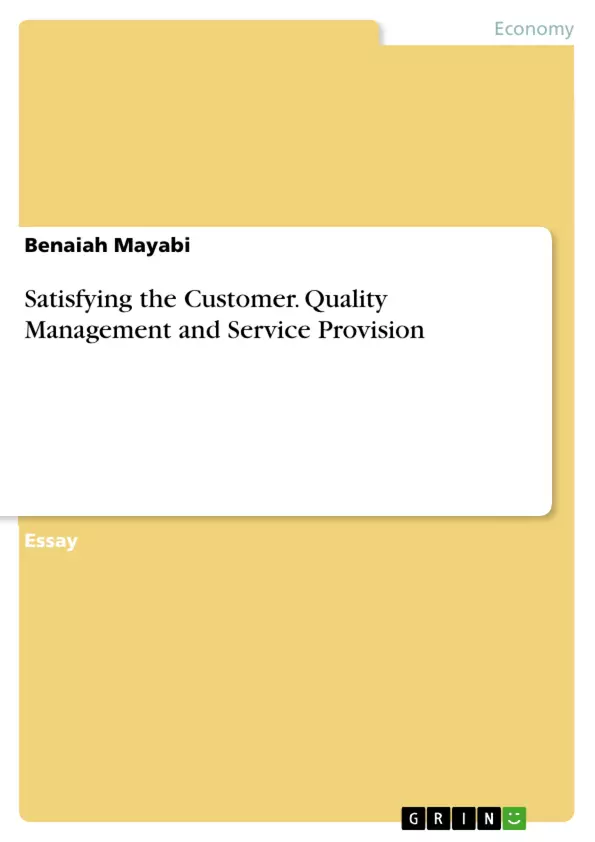Businesses have to continue improving the quality of their goods or services to meet the needs of their clients. There are a number of things that determine the quality of such goods or services and one of them is quality management. The process of quality management, if improperly handled may affect a business' quality and negatively leading to losses. This paper therefore provides an overview of a number of things related to quality management in organizations and how they may help or destroy a business.
Inhaltsverzeichnis (Table of Contents)
- Quality in Business And Service Provision
- Discussion Of The Measurement Of Quality
- Serves the purpose
- Meeting the requirements
- Process Of Inspection And Assurance
- Approaches To Quality Management
- Similarities And Differences Between Different Quality Control Methods
- Quality Systems such as ISO9001, ISO14001 and PQASSO exist
- Total Quality Management
- Meaning Of Customer Satisfaction
- Concept of Continuous Improvement
Zielsetzung und Themenschwerpunkte (Objectives and Key Themes)
This paper aims to explore the concept of quality in business and service provision, examining how organizations strive to satisfy their customers. It investigates the role of quality management in achieving customer satisfaction, analyzing various approaches and methods employed by businesses.
- The importance of quality in meeting customer needs and expectations.
- Different methods and approaches to quality management.
- The role of customer satisfaction in ensuring business success.
- The concept of continuous improvement and its relevance to quality management.
- The importance of staff involvement and collaboration in quality management.
Zusammenfassung der Kapitel (Chapter Summaries)
- Quality in Business And Service Provision: This chapter introduces the concept of quality in business and service provision, highlighting the importance of meeting customer needs and expectations. It discusses the tangible and intangible nature of products and services and the implications of failing to meet customer expectations.
- Discussion Of The Measurement Of Quality: This section delves into the measurement of quality, focusing on two key aspects: a product's ability to serve its intended purpose and its ability to meet market requirements. It provides examples to illustrate these concepts.
- Process Of Inspection And Assurance: This chapter outlines the process of inspection and assurance, emphasizing the importance of quality planning, quality assurance, and quality control. It explains the role of quality management systems and their impact on an organization's assurance and control.
- Approaches To Quality Management: This chapter examines various approaches to quality management, highlighting the importance of staff involvement, management cooperation, and the use of systems such as PDCA (Plan-Do-Check-Act). It also discusses the need for individual attention to projects and ongoing staff training.
- Similarities And Differences Between Different Quality Control Methods: This section explores the similarities and differences between various quality control methods, such as ISO9001, ISO14001, and PQASSO. It discusses the specific roles of each system and how they contribute to quality improvement, customer satisfaction, and environmental concerns.
- Meaning Of Customer Satisfaction: This chapter defines customer satisfaction as the extent to which a product or service exceeds customer expectations. It explores strategies for ensuring customer satisfaction, including listening to customer feedback, listening to employees, and conducting reality checks through surveys.
- Concept of Continuous Improvement: This section introduces the concept of Kaizen, a philosophy that emphasizes continuous improvement in products and services. It highlights the importance of measuring results, implementing best practices, and empowering employees to own the process.
Schlüsselwörter (Keywords)
This text focuses on the concept of quality in business and service provision, examining various approaches to quality management and their impact on customer satisfaction. Key themes include customer needs and expectations, quality assurance and control, continuous improvement, and the role of staff involvement in achieving quality goals. Concepts such as ISO9001, ISO14001, PQASSO, and Total Quality Management are discussed in relation to their specific roles in quality management systems.
- Quote paper
- Benaiah Mayabi (Author), 2018, Satisfying the Customer. Quality Management and Service Provision, Munich, GRIN Verlag, https://www.grin.com/document/417366



